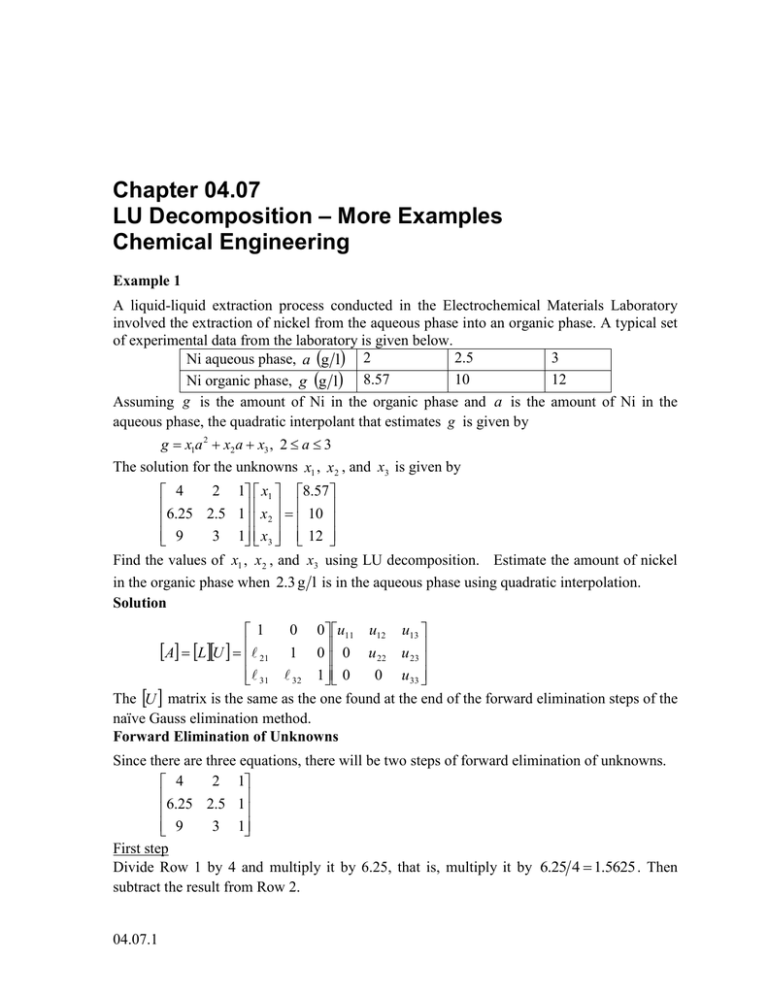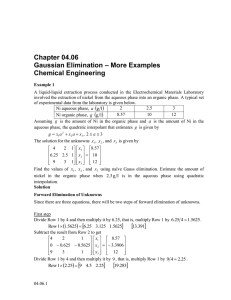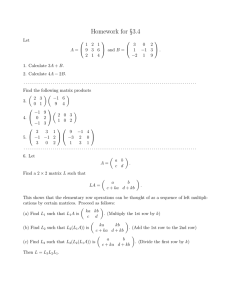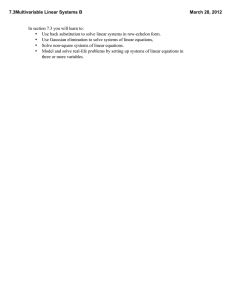Chapter 04.07 – More Examples LU Decomposition Chemical Engineering
advertisement

Chapter 04.07 LU Decomposition – More Examples Chemical Engineering Example 1 A liquid-liquid extraction process conducted in the Electrochemical Materials Laboratory involved the extraction of nickel from the aqueous phase into an organic phase. A typical set of experimental data from the laboratory is given below. 2.5 3 Ni aqueous phase, a g l 2 10 12 Ni organic phase, g g l 8.57 Assuming g is the amount of Ni in the organic phase and a is the amount of Ni in the aqueous phase, the quadratic interpolant that estimates g is given by g x1a 2 x2 a x3 , 2 a 3 The solution for the unknowns x1 , x2 , and x3 is given by 2 1 x1 8.57 4 6.25 2.5 1 x 10 2 9 3 1 x3 12 Find the values of x1 , x2 , and x3 using LU decomposition. Estimate the amount of nickel in the organic phase when 2.3 g l is in the aqueous phase using quadratic interpolation. Solution 0 1 A LU 21 1 31 32 0 u11 u12 u13 0 0 u 22 u 23 1 0 0 u 33 The U matrix is the same as the one found at the end of the forward elimination steps of the naïve Gauss elimination method. Forward Elimination of Unknowns Since there are three equations, there will be two steps of forward elimination of unknowns. 2 1 4 6.25 2.5 1 9 3 1 First step Divide Row 1 by 4 and multiply it by 6.25, that is, multiply it by 6.25 4 1.5625 . Then subtract the result from Row 2. 04.07.1 04.07.2 Chapter 04.07 2 1 4 Row 2 Row 1 1.5625 0 0.625 0.5625 9 3 1 Divide Row 1 by 4 and multiply it by 9 , that is, multiply it by 9 4 2.25 . Then subtract the result from Row 3. 2 1 4 Row 3 Row 1 2.25 0 0.625 0.5625 0 1.5 0.1 Second step Now divide Row 2 by 0.625 and multiply it by 1.5 , that is, multiply it by 1.5 0.625 2.4 . Then subtract the result from Row 3. 2 1 4 Row 3 Row 2 2.4 0 0.625 0.5625 0 0 0.1 2 1 4 U 0 0.625 0.5625 0 0 0.1 Now find L . 0 0 1 L 21 1 0 31 32 1 From Step 1 of the forward elimination process 6.25 21 = 1.5625 4 9 31 = 2.25 4 From Step 2 of the forward elimination process 1.5 32 = 2.4 0.625 0 0 1 L 1.5625 1 0 2.25 2.4 1 Now that L and U 0 1 1.5625 1 2.25 2.4 gives are known, solve LZ C . 0 z1 8.57 0 z 2 10 1 z 3 12 LU Decomposition-More Examples: Chemical Engineering z1 8.57 1.5625z1 z 2 10 2.25z1 2.4 z 2 z 3 12 Forward substitution starting from the first equation gives z1 8.57 z 2 10 1.5625z1 10 1.5625 8.57 3.3906 z 3 12 2.25 z1 2.4 z 2 12 2.25 8.57 2.4 3.3906 0.855 Hence z1 8.57 Z z 2 3.3906 z 3 0.855 Now solve U X Z . 2 1 x1 8.57 4 0 0.625 0.5625 x 3.3906 2 0 0 0.1 x3 0.855 4 x1 2 x2 x3 8.57 0.625x2 (0.5625) x3 3.3906 0.1x3 0.855 From the third equation, 0.1x3 0.855 0.855 x3 0.1 8.55 Substituting the value of x3 in the second equation, 0.625x2 (0.5625) x3 3.3906 3.3906 (0.5625) x3 0.625 3.3906 (0.5625) 8.55 0.625 2.27 Substituting the value of x2 and x3 in the first equation, 4 x1 2 x2 x3 8.57 x2 04.07.3 04.07.4 Chapter 04.07 8.57 2 x2 x3 4 8.57 2 (2.27) 8.55 4 1.14 The solution vector is x1 1.14 x 2.27 2 x3 8.55 x1 The polynomial that passes through the three data points is then g a x1 a 2 x 2 a x3 1.14a 2 2.27 a 8.55, 2 a 3 where g is the amount of nickel in the organic phase and a is the amount of nickel in the aqueous phase. When 2.3 g l is in the aqueous phase, using quadratic interpolation, the estimated amount of nickel in the organic phase is 2 g 2.3 1.14 2.3 2.27 2.3 8.55 9.3596 g/l SIMULTANEOUS LINEAR EQUATIONS Topic LU Decomposition – More Examples Summary Examples of LU decomposition Major Chemical Engineering Authors Autar Kaw July 12, 2016 Date Web Site http://numericalmethods.eng.usf.edu



